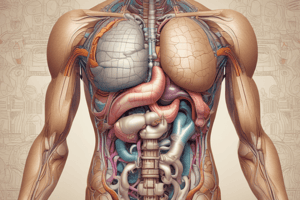Podcast
Questions and Answers
Which organ does NOT form part of the alimentary canal?
Which organ does NOT form part of the alimentary canal?
- Pancreas (correct)
- Large intestine
- Anus
- Rectum
What process describes the movement of food down the esophagus?
What process describes the movement of food down the esophagus?
- Egestion
- Absorption
- Mechanical digestion
- Peristalsis (correct)
What role does bile play in digestion?
What role does bile play in digestion?
- Store glucose
- Break down proteins
- Aid digestion of fats and neutralise stomach acid (correct)
- Digest carbohydrates
Which of the following definitions correctly describes absorption?
Which of the following definitions correctly describes absorption?
What is the function of hydrochloric acid in the stomach?
What is the function of hydrochloric acid in the stomach?
What is mechanical digestion primarily concerned with?
What is mechanical digestion primarily concerned with?
Where are amylase, protease, and lipase enzymes produced?
Where are amylase, protease, and lipase enzymes produced?
What is formed from solid waste in the colon?
What is formed from solid waste in the colon?
Flashcards
Mechanical Digestion
Mechanical Digestion
The process of breaking down food into smaller pieces using physical means, like chewing, without changing the chemical composition of the food molecules.
Absorption
Absorption
The process of absorbing small food molecules and ions into the bloodstream through the intestinal wall.
Egestion
Egestion
The removal of undigested or unabsorbed food from the body as faeces.
Assimilation
Assimilation
Signup and view all the flashcards
Oesophagus (or Esophagus)
Oesophagus (or Esophagus)
Signup and view all the flashcards
Hydrochloric Acid
Hydrochloric Acid
Signup and view all the flashcards
Bile
Bile
Signup and view all the flashcards
Duodenum
Duodenum
Signup and view all the flashcards
Study Notes
Digestive System Overview
- The digestive system includes organs that form the alimentary canal (food passes through) and accessory organs (aid digestion).
- Alimentary canal organs include the large intestine (colon, rectum, anus).
- Accessory organs include structures not directly involved in food passage.
Digestive Processes
- Mechanical digestion: physically breaking down food into smaller pieces without changing its molecules.
- Absorption: moving small food molecules and ions into the bloodstream from the intestines.
- Egestion: eliminating undigested food as faeces.
- Assimilation: absorbing nutrients into body cells after absorption into the blood.
Ingestion and Mechanical Digestion
- Ingestion occurs first, where food enters the body.
- Teeth mechanically break down food particles.
Peristalsis
- Peristalsis is the muscular contractions that force food down the esophagus.
Stomach Function
- Hydrochloric acid in the stomach sets a suitable pH for enzymes and kills pathogens.
Liver and Bile
- Bile aids fat digestion and neutralizes stomach acid.
- Bile is stored in the gallbladder before release into the duodenum.
Pancreas
- The pancreas produces digestive enzymes (amylase, protease, lipase) released into the duodenum.
Small Intestine (Ileum)
- The ileum absorbs food and water into the bloodstream through villi.
Large Intestine
- The large intestine absorbs water from food and forms faeces.
Digestive System Expertise
- Lára, a science tutor, has expertise in biological sciences, infectious disease, and epidemiology.
- Lucy, a mathematics teacher with significant experience, excels in supporting and developing maths teaching techniques.
Studying That Suits You
Use AI to generate personalized quizzes and flashcards to suit your learning preferences.




